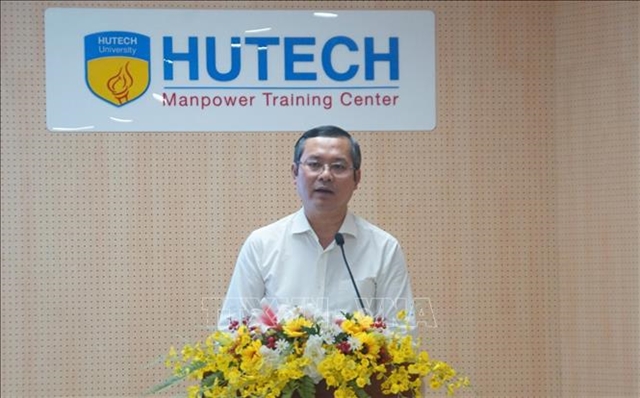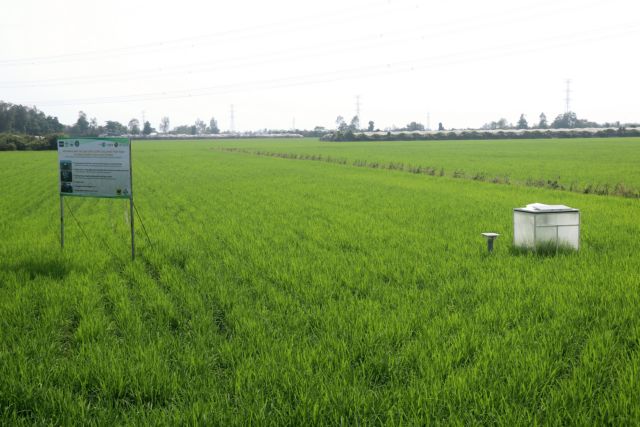 Society
Society


|
| A low-emissions rice field at the New Green Farm Cooperative in Cần Thơ City. — VNA/VNS Photo Thu Hiền |
HÀ NỘI — Current crop production models must be transformed into those that provide low emissions, sustainability, and flexible adaptation to climate change, said Deputy Minister of Agriculture and Environment Hoàng Trung.
Speaking at a conference on crop production held by the Ministry of Agriculture and Environment (MAE) on Wednesday in Hà Nội, Trung said that the MAE is developing a project to reduce agriculture-related emissions over the next decade.
The project is aimed at increasing added value in the crop production chain, ensuring sustainable development and implementing the country's Nationally Determined Contribution (NDC) under the Paris Agreement.
Việt Nam emitted a total of around 454.6 million tonnes of carbon dioxide in 2020, nearly double the emissions in 2010, according to the Institute of Agricultural Environment.
Of these emissions, the agricultural sector accounted for more than 116 million tonnes, with the crop sector alone releasing up to 80 per cent of the total agricultural emissions, mainly from rice cultivation, ineffective use of fertilisers, and post-harvest straw burning.
If low-emissions agriculture models are properly and systematically implemented with appropriate technical solutions, emissions reductions in crop production could be seen nationwide as well as in each farming household, said Trung.
With an ultimate aim of achieving a globally competitive, sustainable agriculture industry in harmony with nature, Trung confirmed that the project's overall goal is for the domestic crop production industry to reduce greenhouse gas emissions.
The project will ultimately help Việt Nam meet its NDC obligations and carry out plans outlined in Government and MAE decisions.
Nguyễn Thị Thu Hương, deputy director of the Department of Crop Production and Plant Protection, said that the project is not only an action plan but also a strong commitment from the Vietnamese agricultural sector to work towards the global goal of achieving net zero emissions by 2050.
Solutions implemented under the initiative will promote the transformation of crop production systems into low emissions models and help the sector adapt to climate change, increase incomes, improve people's quality of life, and boost sustainable development.
It will also help enhance Vietnamese crops' competitiveness, ensure national food security, and form a modern, ecological agricultural sector.
One major goal of the project is that by 2035, the sector's methane emissions will be at least 30 per cent lower and all greenhouse gas emissions will be reduced by at least 10 per cent compared to 2020.
A ‘Low Emissions’ label for products will also be developed through the initiative, which will organise at least 15 emissions reduction models with the potential for replication in other regions.
At least five cultivation models capable of developing carbon credits that meet international requirements will also be piloted.
The initiative will issue at least five technical emissions reduction packages for five key crops, establish a database for crop emissions linked to the National Registration System and hold training sessions on techniques, policies, general awareness and emissions measurement tools for at least 3,000 technical staff, farmers and businesses nationwide.
Seven action items are also outlined under the project: perfecting policies and support tools, flexibly converting crop systems according to each ecological region, applying emissions reduction technology to crop production, implementing production models to reduce emissions in value chains, establishing and operating a measurement, reporting and verification (MRV) system and emissions database, improving capacity and changing awareness, and connecting to markets for low-emission products.
To achieve these objectives, seven types of solutions are planned. These are: strengthening State management; using science, technology and technology transfer; organising the production value chain; building data systems and emissions management software; using financial resources and markets; raising awareness through training and communication; and working on international cooperation and integration.
Sharing her experience at the event, Deputy Director of the Hải Phòng Department of Agriculture and Environment Lương Thị Kiểm said that in previous years, the city used straw to grow winter crops after the harvest to reduce emissions.
The city also promotes the cultivation of low-emissions rice and has developed policies to grow winter crops on two-crop rice cultivation areas to reduce greenhouse gases.
Hải Phòng authorities expressed their desire to participate in the project. They also asked that the project’s content be unified, with appropriate policies to ensure feasibility, and that it can be deployed on a large scale.
From a business perspective, Lê Văn Phương, General Director of the Lam Sơn Sugar Joint Stock Corporation (LASUCO), said that the sugar industry holds great potential for reducing greenhouse gas emissions.
"Sugarcane is an energy crop. The sugar industry has a low carbon advantage because it can use all of its by-products, from molasses, bagasse, straw and tops to produce biofuel, biomass electricity and biogas," he said.
Each tonne of sugarcane can produce about 70 litres of ethanol, while a tonne of molasses yields up to 270 litres. Sugarcane fields can also store up to 60 tonnes of carbon per hectare. Planting once and harvesting many years later also helps reduce emissions from machinery and fossil fuels.
LASUCO is actively improving the technology it uses, increasing turbine efficiency, installing rooftop solar panels, and using additional by-products to reduce its electricity consumption.
"We propose building a voluntary carbon credit mechanism, adjusting the purchase price of electricity from bagasse to 10-13 cents per kWh to encourage businesses to invest in green conversion," Phương said. — VNS




